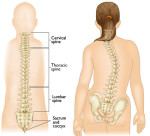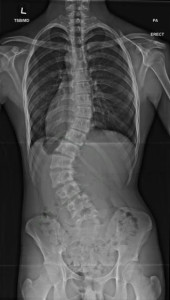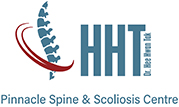Scoliosis or Crooked spine

Scoliosis, or abnormal curving of the spine, affects about 3% of people. A certain degree of curvature is normal in the human spine. When you look at your body from the side, you can see the gentle inward and outward curves of the neck, upper back and lower back. These are necessary for keeping the body properly balanced and aligned over the pelvis.

But when viewed from the back, the vertebrae of a healthy spine should form a straight line. In someone with scoliosis, the spine looks more like an “S” or a “C” than an “I.”
The spinal bones involved in the curve also may rotate to some degree, which can further contribute to the appearance of an uneven waist or shoulders (Figure 1).
Mild cases may not affect daily living. But severe cases (more than 50 degrees) can be painful and limit normal activity (Figure 2).
Causes
There are many causes of scoliosis in the young children, including congenital spine deformities (those present at birth, either inherited or caused by the environment), genetic conditions, and neuromuscular problems (scoliosis due to problems in nerve and muscle control). Examples of neuromuscular scoliosis include cerebral palsy, spinal bifida, muscular dystrophy, and spinal muscular atrophy. Rarely, tumors may be a cause of scoliosis. More than 80% of scoliosis cases, however, have no known cause. They are often called idiopathic.
Most of the scoliosis cases occur during the teenage years, the so called “growth spurt” phase, where scoliosis becomes more obvious and may progress along with the pubertal growth of the teenagers. Sometimes, we see scoliosis cases happening in the much younger children. In the past, doctors categorize such scoliosis into congenital (appearing at birth), infantile (appearing within first year of life), and juvenile. Nowadays, we tend to describe these cases as “early onset scoliosis”, as the management tends to be similar among the cases.
With an ageing population, we are seeing increasing number of patients presenting with scoliosis for the first time during their adult years, especially in the middle aged and beyond. This condition is termed as degenerative scoliosis, and the patients often also complain of back pain with or without leg symptoms e.g. shooting pain, numbness, tingling, and/or weakness. This topic is covered under the Back Pain section.
Symptoms
There are several symptoms to look for to help determine if you or someone you love has scoliosis. Should you notice any one or more of these signs, you should schedule an exam with a doctor.

- Shoulders are different heights – one shoulder blade is more prominent than the other
- Head is not centered directly above the pelvis
- Appearance of a raised, prominent hip
- Rib cages are at different heights (Figure 3)
- Uneven waist
- Changes in look or texture of skin overlying the spine
- Leaning of entire body to one side
- Rib prominence when bent over
Progression
Very mild scoliosis usually doesn’t require any treatment other than regular follow-up with a doctor since it generally doesn’t cause any symptoms. For those with more severe scoliosis, back muscle fatigue and pain may be felt during prolonged periods of standing or sitting.
In some people, the condition can progress and worsen with time. The abnormal compression of the ribs on one side of the body can put pressure on vital organs and can cause a change in function of the heart and lungs if left untreated.
Learn more about the diagnosis and back brace for scoliosis and scoliosis surgery options. Our specialist Adjunct A/Professor Hee Hwan Tak is a renowned spine surgeon with much experience treating scoliosis safely and successfully. Contact us for a comprehensive consultation today.
